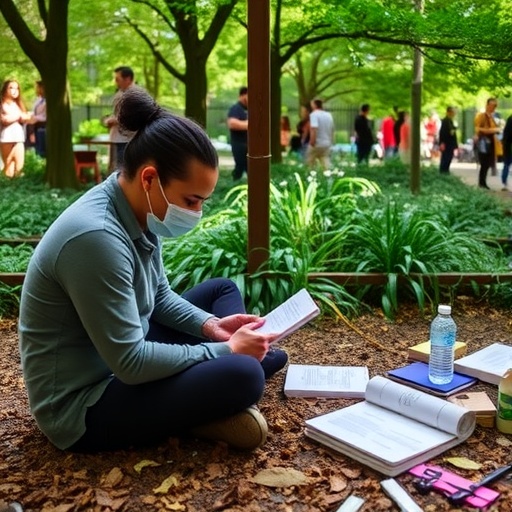A groundbreaking study emerging from New York University reveals how the rise of remote and hybrid work models has fundamentally transformed civic engagement and environmental activism within urban neighborhoods. Drawing from an extensive five-year ethnographic investigation of a volunteer-run composting and gardening initiative in Sunnyside, Queens, the research unveils the intricate ways in which digitally mediated work schedules have enabled New Yorkers to cultivate hands-on environmental participation during their work hours. This revelation underscores a profound shift in the relationship between work, technology, and community-driven ecological stewardship.
Published in the esteemed Proceedings of the ACM on Human-Computer Interaction and presented at the 2025 Aarhus Conference on Critical Computing, the study ventures beyond superficial observations to explore the socio-technical infrastructure underpinning neighborhood-based environmental projects. By focusing on a site initiated in 2020 on a formerly unused lot—known as 45th St Greenspace—the research situates itself at the confluence of urban revitalization, technology adoption, and emergent forms of collective action. The hybrid work revolution, often analyzed through economic and productivity lenses, is here dissected for its ripple effects on local environmental responsiveness and social cohesion.
Central to the findings is the recognition that flexible schedules and the spatial autonomy afforded by work-from-home arrangements have unlocked new opportunities for environmental engagement. Participants, primarily independent and creative professionals such as designers, academics, and media specialists, leveraged their flexible routines to integrate garden maintenance, composting, and infrastructural improvements into otherwise typical workdays. This phenomenon speaks to the broader socio-technical dynamics of the modern workforce, where physical mobility and temporal flexibility enable novel forms of civic participation, translating screen-bound hours into productive green activities.
Moreover, the study identifies psychological and social motivations intertwined with these structural changes. Many volunteers cited a desire to counteract the pervasive isolation and digital fatigue characteristic of remote professional lives, seeking refuge in tactile, outdoor work that fostered face-to-face community connections. This interplay between mental health, workspace design, and environmental activism highlights potential avenues for urban planners and policymakers aiming to enhance both well-being and sustainability through hybrid work policies.
A particularly innovative angle of the research lies in framing 45th St Greenspace as a socio-technical system. This concept extends beyond the physical tools—raised garden beds, compost bins, and horticultural implements—to encompass the digital platforms and cultural schemas imported from participants’ professional domains. Digital communication tools such as Slack, Zoom, and Signal were not merely supplementary but integral to the garden’s governance, enabling horizontal decision-making, fluid collaboration, and distributed leadership structures. This blending of digital work culture with ecological organization challenges traditional dichotomies between the digital and physical spheres.
The governance modalities observed reveal parallels with contemporary workplace structures, including reliance on collaborative workflows and conflict mediation grounded in professional norms. While these structures facilitated effective project management and collective responsibility, they also manifested limitations. The reliance on middle-class communication protocols occasionally alienated volunteers from diverse cultural and linguistic backgrounds, suggesting that inclusivity in digital civic systems requires deliberate attention to varied communicative styles and conflict resolution expectations.
Additionally, the research underscores disparities in sustained participation shaped by access to time, job flexibility, and technological fluency. Parents of young children, individuals engaged in physically demanding or inflexible labor, and those less conversant with digital communication tools were less consistently involved. This finding resonates with broader concerns about digital divides and socio-economic stratification within civic engagement, emphasizing the need for inclusive infrastructure that accommodates diverse life circumstances.
The methodological rigor of this investigation is noteworthy. Conducted by Margaret Jack, an Industry Assistant Professor at NYU’s Tandon School of Engineering and a long-term community member, the study leveraged ethnographic participant observation, reflective journaling, interviews, and surveys. The multi-method autoethnographic approach provides a nuanced understanding of lived experiences and system dynamics, transcending simplistic quantitative analyses to capture the complexities at the intersection of technology, environment, and social practice.
Further enriching the research are comparative field studies engaged in collaboration with other New York City community gardens, expanding the analytical frame beyond a single site. This pluralistic approach illuminates common patterns and divergences in the interplay of digital tools, environmental action, and social organization in diverse urban contexts. Such comparative insights bear significant implications for the design of civic technologies attuned to local cultures and infrastructural realities.
The imminent closure of 45th St Greenspace, precipitated by private real estate development, symbolizes a broader tension between urban ecological initiatives and economic pressures. Nevertheless, as a microcosm of emergent trends, the project offers a valuable prototype illustrating how hybrid work modalities reconfigure urban environmental engagement. The transformation of neighborhood participation, mediated by digital coordination and flexible temporal regimes, opens novel prospects for reimagining urban sustainability and civic infrastructure.
From an engineering and design perspective, the study presents compelling questions regarding the adaptation of individually focused productivity tools for collective, public-oriented ecological endeavors. How can digital platforms be reengineered to better support inclusive governance, equitable access, and culturally diverse communication in grassroots environmental projects? These design challenges echo larger discourses within human-centered computing and critical systems engineering, advocating for technologies that are not only efficient but socially and ecologically attuned.
In sum, this research contributes a critical lens on the interdependency of technology, work culture, and environmental activism, revealing new modalities of urban participation catalyzed by the remote work paradigm. It champions a vision of cities that are digitally connected yet physically rooted, socially inclusive yet technologically sophisticated, thus encapsulating the complex dynamics shaping contemporary civic life. As hybrid work arrangements continue to proliferate globally, understanding and harnessing their socio-ecological potential will be imperative for sustainable urban futures.
Subject of Research: People
Article Title: In the Dirt: Place-Based Environmental Action and Technology-Mediated Work in New York City
News Publication Date: 17-Aug-2025
Web References:
References:
Jack, Margaret M. (2025). In the Dirt: Place-Based Environmental Action and Technology-Mediated Work in New York City. Proceedings of the ACM on Human-Computer Interaction. DOI: 10.1145/3744169.3744176
Keywords: Environmental policy




